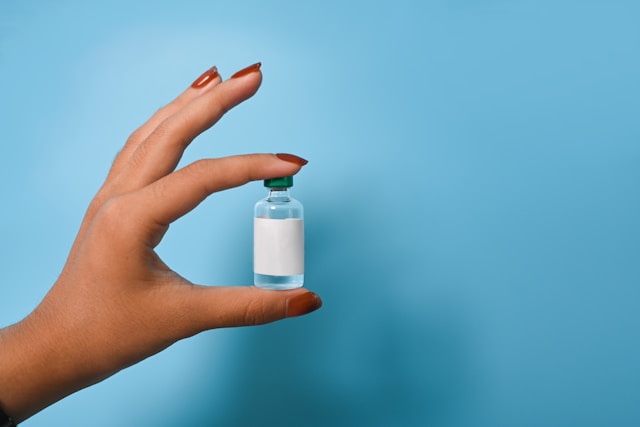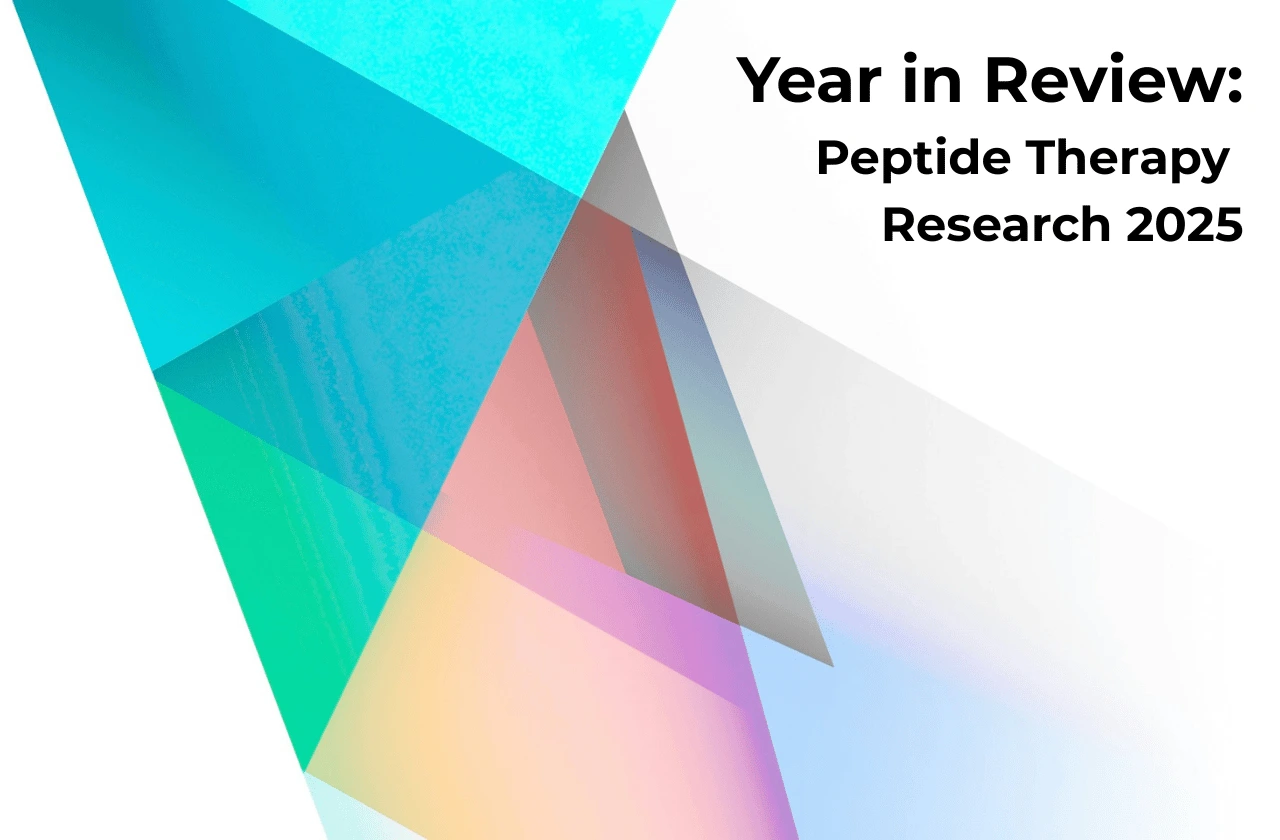[Disclaimer: This article is for informational purposes only and does not constitute medical advice. Always consult with a qualified healthcare provider before considering any peptide therapy.]
PEG-MGF stands out from traditional muscle-building supplements. This PEGylated version of MGF peptide delivers extended muscle-building signals that can accelerate muscle repair and support tissue regeneration in ways conventional approaches simply cannot match.
Proper dosage protocols, potential side effects, and individual response patterns form the foundation for making informed decisions about incorporating this peptide therapy into your clinical practice or bodybuilding routine.
What’s more, research shows this modified growth factor can stimulate muscle stem cells and enhance the body’s natural repair processes when used correctly.
Quick Takeaways
- PEG-MGF is a synthetic peptide that extends natural muscle growth signals to accelerate recovery and support muscle repair.
- Research shows it can reduce muscle soreness, speed healing, and help activate the stem cells responsible for muscle growth.
- Dosing typically ranges from 150-400 mcg injected 2-3 times weekly, with beginners starting at lower doses to assess tolerance.
- Limited human studies and potential side effects like blood sugar changes mean medical supervision is recommended for safe use.
What is PEG-MGF Peptide?
PEG-MGF (PegylatedMechano Growth Factor) is a synthetic peptide derived from mechano growth factor (MGF), which itself represents a variant of insulin-like growth factor-1 (IGF-1). The peptide consists of the primary MGF sequence conjugated with polyethylene glycol (PEG) through a process called pegylation.
Here’s what makes it special. MGF contains a unique E-domain region, typically consisting of 24-25 amino acids, that differentiates it from standard IGF-1 and exhibits distinct biological activities. This E-domain is responsible for many of MGF’s specialized tissue repair and regeneration properties.
The problem with natural MGF? It breaks down too quickly. This modification dramatically extends the peptide’s half-life from mere minutes (for native MGF) to several hours or even days, making it significantly more practical for therapeutic use. Research demonstrates that pegylation stabilizes the molecule and reduces enzymatic degradation, allowing for sustained anabolic signaling over extended periods1.
Natural production follows a predictable pattern. MGF is naturally produced by muscle tissue in response to mechanical stress, such as during resistance training or injury. Research demonstrates that MGF expression increases significantly (4-6 fold) within 72 hours following acute muscle damage2.
However, its extremely short half-life limits its effectiveness as a therapeutic agent. For this reason, the addition of polyethylene glycol addresses this limitation by creating a more stable molecule that maintains biological activity for longer durations.
The Science Behind PEGylation
The PEGylation process involves attaching polyethylene glycol chains to the MGF peptide backbone. This chemical modification serves multiple purposes:
- Extended circulation time – PEG chains protect the peptide from rapid breakdown
- Improved stability – Reduced susceptibility to enzymatic degradation
- Enhanced bioavailability – More predictable absorption and distribution
- Sustained activity – Prolonged therapeutic window for muscle adaptation
How PEG-MGF Works for Muscle Growth and Recovery
PEG-MGF operates through several interconnected pathways that promote muscle repair and growth, making it particularly valuable for those seeking to enhance muscle recovery and stimulate muscle regeneration.
Satellite Cell Activation
The primary mechanism involves binding to insulin-like growth factor-1 receptors on muscle cells, which initiates intracellular signaling cascades that activate satellite cells. These stem cells represent the key cellular components responsible for muscle repair and regeneration.
Studies indicate that activated satellite cells proliferate, differentiate, and fuse with existing muscle fibers to repair damage and contribute new nuclei for muscle growth3. This process supports both immediate muscle damage recovery and long-term muscle mass development.
Localized Growth Response
Unlike systemic growth factors, PEG-MGF can be injected near trained muscle groups, allowing for site-specific targeting. This localized approach enables muscle-specific adaptation and proves particularly useful for addressing lagging body parts or accelerating recovery from muscle damage.
The peptide’s ability to provide targeted muscle tissue support means users can direct its effects to specific areas requiring enhanced recovery or growth stimulation.
Extended Anabolic Window
The pegylation extends MGF’s bioavailability, creating a prolonged anabolic signaling window. This gives satellite cells more time to respond, replicate, and contribute to muscle regeneration. The extended activity window represents what makes PEG-MGF superior to natural MGF for promoting muscle adaptation.
Research suggests this prolonged signaling can enhance muscle growth more effectively than shorter-acting growth factors by maintaining consistent anabolic signals over extended periods.
Third-Party Tested, 99% Purity
Order lab-verified peptides from our top recommended vendor.

Benefits of PEG-MGF for Muscle Health
PEG-MGF offers a comprehensive approach to muscle health that addresses multiple aspects of training adaptation and recovery.
Enhanced Muscle Recovery
Recovery time matters for serious athletes. PEG-MGF accelerates the muscle repair process following intense training by stimulating muscle stem cells, promoting myogenic differentiation, and encouraging muscle fiber regeneration.
The practical impact is measurable. This leads to faster recovery times and the ability to train more frequently. Athletes and bodybuilders often report significant improvements in recovery between training sessions, allowing for increased training frequency without compromising performance or risking overtraining.
Reduction in Muscle Soreness
Nobody enjoys debilitating DOMS. The peptide can significantly reduce delayed onset muscle soreness (DOMS) by enhancing inflammatory resolution, speeding up tissue repair, and minimizing muscle stiffness and pain.
What this means for your training: This enables more consistent training with less downtime between workouts. The improved recovery profile allows for maintenance of training intensity while reducing the typical discomfort associated with intensive muscle-building protocols.
Improved Muscle Density and Hypertrophy
Building better muscle takes more than just size. Long-term use may lead to thicker, denser muscle fibers with greater tensile strength, potentially reducing the risk of training-related injuries. Research suggests that PEG-MGF can stimulate muscle cell division and aid in increased muscle tissue growth.
Enhanced Satellite Cell Proliferation
Satellite cells determine your muscle-building ceiling. Studies indicate that MGF can significantly increase the activation of satellite cells, with PEG-MGF offering an extended therapeutic window due to its pegylated nature.
The bottom line: This enhanced satellite cell response proves crucial for both muscle repair and hypertrophy adaptations.
Stem Cell Recruitment and Migration
PEG-MGF acts as a stem cell homing factor, attracting stem cells to sites of injury and supporting comprehensive tissue regeneration. Research demonstrates increased recruitment of proliferating bone marrow cells to injured muscles expressing MGF4.
Studies show that MGF E-domain peptide produces greater chemotactic migration in human mesenchymal stem cells compared to IGF-1 peptide alone. This enhanced migration capacity supports faster and more effective tissue repair processes.
Anti-Apoptotic Properties
Research demonstrates that MGF peptide reduces apoptosis in myocytes and provides protective effects against cell death5. This anti-apoptotic activity represents one of MGF’s key therapeutic mechanisms, helping preserve existing muscle tissue while promoting new growth.
Expanded Therapeutic Applications of PEG-MGF
Cardiovascular Health Benefits
Beyond muscle applications, PEG-MGF shows promise for cardiovascular health. Research indicates that localized delivery of MGF E-domain peptide via specialized delivery systems improved cardiac function following myocardial infarction in experimental models6. The treatment enhanced tissue repair and reduced cardiac damage.
Neural Regeneration and Neuroprotection
MGF demonstrates neuroprotective effects that extend its therapeutic potential beyond muscle tissue. Studies show that MGF-Ct24E demonstrated neuroprotective effects in primary cortical neurons and improved rehabilitation following traumatic brain injury in animal models7. The peptide promoted axonal growth and enhanced expression of neural guidance factors.
Bone and Connective Tissue Healing
PEG-MGF applications extend to various musculoskeletal healing processes:
- Bone Defect Healing: Research demonstrates enhanced bone defect healing in rabbit models with 1.4 times greater proliferation activity than IGF-1, indicating superior bone regeneration capabilities8.
- Tendon Repair: Studies show improved tendon healing in injured rat models, with enhanced tissue repair and reduced recovery times9.
- Meniscus Regeneration: MGF treatment promotes meniscus repair by enhancing cell proliferation, migration, and collagen synthesis, supporting comprehensive joint health10.
PEG-MGF Dosage and Administration Guidelines
Getting the dosage right makes all the difference. Most users follow a 2-3 times weekly dosing schedule with carefully calibrated parameters to maximize benefits while minimizing risks.
Standard Dosing Protocols by Experience Level
| Experience Level | Dose Per Injection | Frequency | Duration | Key Focus |
|---|---|---|---|---|
| Beginner | 150-200 mcg | 2x per week | 4 weeks max | Conservative start, assess response |
| Intermediate | 200-300 mcg | 2-3x per week | 5-6 weeks max | Target specific muscle groups |
| Advanced | 300-400 mcg | 3x per week | 6 weeks max | Rotate sites, strategic targeting |
Start conservative and adjust based on response. This approach allows you to assess individual tolerance and effectiveness before increasing dosage or frequency.
Injection Method and Timing – When and Where
Timing matters for maximum effectiveness. PEG-MGF is administered via subcutaneous or intramuscular injection using insulin syringes (29-31 gauge) for minimal discomfort.
Best practices include:
- Post-workout timing – Inject within 30-60 minutes to capitalize on natural muscle stress signals
- Localized placement – Near the trained muscle group for enhanced response to muscle damage
- Site rotation – Rotate injection sites to prevent tissue irritation and maintain effectiveness
Storage and Preparation – Keeping It Stable
Proper handling preserves potency. The peptide typically arrives in lyophilized powder form requiring reconstitution:
- Mix with bacteriostatic water according to manufacturer instructions
- Store refrigerated (2-8°C) after reconstitution to maintain peptide stability
- Use within 7-10 days of mixing for optimal potency
Side Effects of PEG-MGF – What You Need to Know
Most side effects are manageable and temporary. Understanding what to expect helps you make informed decisions and recognize normal responses versus concerning symptoms.
Common Side Effects – The Expected Responses
Local reactions top the list and represent the most frequently reported side effects:
- Injection site reactions: Redness, swelling, or tenderness that typically resolves within 24-72 hours
- Minor irritation: Itching or mild discomfort that fades quickly
- Bruising: Small bruises at injection locations (normal with any injection)
Systemic effects may include:
- Fatigue or mild flu-like symptoms during initial use periods
- Headaches and occasional nausea
- Temporary dizziness following injection
- Muscle tightness or cramps due to localized growth factor activity
- Minor water retention, particularly when combined with other compounds
Serious Considerations – When to Pay Attention
Blood sugar drops require monitoring. Hypoglycemia risk represents a significant concern, as PEG-MGF may cause drops in blood sugar levels. This proves particularly concerning for individuals with diabetes or those prone to hypoglycemic episodes.
What to watch for: Monitor blood glucose levels and remain aware of symptoms like shakiness, sweating, confusion, or weakness.
Cell growth concerns are theoretical but important. Because PEG-MGF promotes cell proliferation, theoretical risk exists for stimulating unwanted tissue growth.
PEGylation-Specific Concerns deserve attention as well. While PEG conjugation offers stability benefits, research indicates potential adverse outcomes including pre-existing and treatment-induced anti-PEG antibodies that may result in increased drug clearance11. Large PEG molecules (>20-30 kDa) may accumulate in renal and other tissues, requiring monitoring for long-term effects.
Higher risk individuals should avoid PEG-MGF:
- Pre-existing tumors or cancer history
- High genetic risk factors for malignancy
- Active inflammatory conditions requiring medical management
Contraindications – Who Should Avoid PEG-MGF
Safety comes first. PEG-MGF should be avoided or used only under medical supervision in individuals with:
- Active cancer or tumor history
- Acute critical illness requiring medical intervention
- Diabetes requiring careful blood sugar monitoring
- Pregnancy or breastfeeding
- Evidence of existing abnormal tissue growth
PEG-MGF for Bodybuilding and Competitive Performance
Bodybuilders have discovered PEG-MGF’s unique advantages for supporting muscle development during intense training phases. The peptide’s localized effects make it particularly valuable for addressing specific training challenges.
Competitive Applications – Where It Makes a Difference
Contest prep presents unique challenges. PEG-MGF has gained attention in bodybuilding circles for its ability to support muscle retention and growth during demanding training phases:
- Contest preparation – Maintaining muscle mass during caloric restriction periods
- Off-season growth phases – Supporting muscle mass development when calories allow
- Injury recovery – Accelerating healing of training-related muscle damage
- Plateau breaking – Stimulating growth in stubborn, lagging muscle groups
Strategic Stacking for Synergistic Effects
Combining peptides can amplify results when done thoughtfully. PEG-MGF works well with complementary compounds:
| Purpose | Primary Peptide | Supporting Compounds | Typical Dosing |
|---|---|---|---|
| Muscle Growth | PEG-MGF (200-300 mcg) | IGF-1 LR3 (50-100 mcg daily) | Post-workout timing |
| CJC-1295 + Ipamorelin (100 mcg each) | Before bed | ||
| Recovery & Healing | PEG-MGF (200-400 mcg) | BPC-157 (250 mcg daily) | Target injured areas |
| TB-500 (2-5 mg/week) | Systemic healing |
Don’t forget the basics. Comprehensive protein supplementation remains the foundation for supporting muscle protein synthesis, regardless of peptide use.
Training Integration Strategies
Smart implementation requires planning. When incorporating PEG-MGF into training protocols, consider these approaches:
Pre-implementation assessment starts with evaluating current recovery capacity and training volume. Progressive implementation means starting with lower doses and assessing individual response before increasing.
Cycle timing should align peptide cycles with intensive training blocks for maximum benefit. Recovery monitoring involves tracking improvements in recovery metrics and overall training capacity.
What’s more, successful users typically maintain detailed logs of dosing, injection sites, recovery improvements, and any side effects experienced.
💡PEPTIDE PICKS: MORE TO EXPLORE
- Ready to take your muscle-building to the next level? Discover our comprehensive guide to the best peptides for bodybuilding and how to use them safely.
- Looking to optimize your athletic performance naturally? Check out our roundup of the top peptides that endurance athletes and competitors swear by.
- Want to target fat loss while preserving muscle mass? Explore the best peptide options specifically designed for female body composition goals.
Training Integration
When incorporating PEG-MGF into training protocols, consider these strategies:
- Pre-training assessment – Evaluate current recovery capacity and training volume
- Progressive implementation – Start with lower doses and assess individual response
- Cycle timing – Align peptide cycles with intensive training blocks
- Recovery monitoring – Track improvements in recovery metrics and training capacity
Research and Clinical Evidence: What Science Shows Us
The research landscape continues to evolve as scientists investigate PEG-MGF’s mechanisms and applications across different therapeutic areas.
Current Research Status – Promising but Limited
The data shows clear biological activity. The scientific understanding of PEG-MGF continues to evolve, with most research conducted in animal models and preliminary human studies. Research findings demonstrate the peptide’s ability to activate satellite cells and promote muscle regeneration, with MGF expression showing 4-6 fold increases within 72 hours following acute muscle damage12.
But significant limitations exist. A notable study by Fornaro et al. (2014) failed to reproduce claimed effects of MGF peptides on human muscle myoblast proliferation, raising questions about some promotional claims surrounding the peptide’s physiological role13.
Human data remains scarce. The majority of MGF research has been conducted in animal models or cell culture systems, with limited human clinical trial data available for comprehensive safety and efficacy evaluation.
Key Mechanistic Findings
Several pathways show consistent activity across multiple studies:
- IGF-1 receptor pathway activation leading to downstream anabolic signaling cascades
- Satellite cell recruitment and proliferation supporting muscle repair mechanisms
- Anti-apoptotic effects potentially preserving muscle tissue during stress periods
- Localized growth factor activity providing targeted muscle tissue support
Long-term Safety Research is Still Developing
We’re still learning about long-term effects. Due to limited long-term human studies, the complete safety profile of PEG-MGF remains under investigation. Most knowledge about effects and side effects comes from anecdotal reports and short-term studies rather than comprehensive clinical trials.
This limitation matters. This represents a significant consideration for individuals contemplating long-term use, making careful monitoring and conservative dosing approaches prudent choices.
Safety Considerations and Regulatory Status
Regulatory Position
PEG-MGF exists in a regulatory gray area in many jurisdictions. The peptide is considered a performance-enhancing substance and may be banned by organizations such as the World Anti-Doping Agency (WADA). Professional athletes should verify its legality within their sport before use.
For recreational use, the regulatory status varies significantly by location and intended application. Users should research local laws and regulations before acquiring or using PEG-MGF.
Medical Supervision Recommendations
Given the experimental nature of PEG-MGF and potential for serious side effects, medical supervision provides valuable safety oversight. Healthcare providers can:
- Monitor blood glucose levels to prevent hypoglycemic episodes
- Assess contraindications based on individual health history
- Track biomarkers for early detection of adverse effects
- Provide guidance on proper administration techniques
Risk Mitigation Strategies
Users can minimize potential risks through several approaches:
- Conservative dosing – Start with lower doses and increase gradually based on response
- Proper injection technique – Use sterile procedures and rotate injection sites
- Regular monitoring – Track recovery metrics, side effects, and overall response
- Cycle management – Implement appropriate on/off cycling to prevent desensitization
Bottom Line
PEG-MGF offers promising potential for muscle health optimization. This advanced peptide represents a significant development in targeted muscle recovery and growth support, providing benefits through enhanced satellite cell activation and extended anabolic signaling.
The localized approach sets it apart. The peptide’s ability to provide targeted muscle tissue support makes it particularly appealing for addressing specific muscle development and recovery challenges that traditional approaches cannot match.
But informed decision-making remains crucial. Users must carefully weigh these potential benefits against known risks and current research limitations. PEG-MGF appears most suitable for experienced individuals who understand proper injection protocols, dosing guidelines, and safety monitoring requirements.
Key Takeaways for Potential Users
Start smart and stay safe:
- Begin conservatively – Start with lower doses and monitor individual response carefully
- Master the technique – Proper injection methods and consistent site rotation prevent complications
- Monitor your health – Watch for hypoglycemia risk and track blood sugar when applicable
- Know your limitations – Avoid use with cancer history or other medical contraindications
- Acknowledge the unknowns – Recognize the experimental nature and limited long-term safety data
- Seek professional guidance – Consult qualified healthcare professionals before beginning any peptide protocol
The bottom line: While PEG-MGF shows promise for accelerating muscle recovery and supporting hypertrophy, its experimental status and potential risks warrant a cautious, well-informed approach. This variant of insulin-like growth factor offers unique benefits for muscle repair and regeneration, but these must be balanced against individual risk tolerance and health status.
Success requires preparation. PEG-MGF offers potential as a tool for enhanced muscle recovery and growth, but optimal outcomes depend on thorough understanding of its mechanisms, proper dosing protocols, and vigilant safety monitoring. As research continues to evolve, staying informed about new findings and adjusting approaches accordingly becomes part of responsible use.
References
- Sharda N, Khandelwal P, Zhang L, Caceres-Cortes J, Marathe P, Chimalakonda A. Pharmacokinetics of 40 kDa Polyethylene glycol (PEG) in mice, rats, cynomolgus monkeys and predicted pharmacokinetics in humans. Elsevier BV; 2021. p. 105928. https://doi.org/10.1016/j.ejps.2021.105928. doi:10.1016/j.ejps.2021.105928
- Matheny RW, Nindl BC, Adamo ML. Minireview: Mechano-Growth Factor: A Putative Product of IGF-I Gene Expression Involved in Tissue Repair and Regeneration. The Endocrine Society; 2010. p. 865–875. https://doi.org/10.1210/en.2009-1217. doi:10.1210/en.2009-1217
- Hill M, Wernig A, Goldspink G. Muscle satellite (stem) cell activation during local tissue injury and repair. Wiley; 2003. p. 89–99. https://doi.org/10.1046/j.1469-7580.2003.00195.x. doi:10.1046/j.1469-7580.2003.00195.x
- Musarò A, Giacinti C, Borsellino G, Dobrowolny G, Pelosi L, Cairns L, Ottolenghi S, Cossu G, Bernardi G, Battistini L, et al. Stem cell-mediated muscle regeneration is enhanced by local isoform of insulin-like growth factor 1. Proceedings of the National Academy of Sciences; 2004. p. 1206–1210. https://doi.org/10.1073/pnas.0303792101. doi:10.1073/pnas.0303792101
- Doroudian G, Pinney J, Ayala P, Los T, Desai TA, Russell B. Sustained delivery of MGF peptide from microrods attracts stem cells and reduces apoptosis of myocytes. Springer Science and Business Media LLC; 2014. p. 705–715. https://doi.org/10.1007/s10544-014-9875-z. doi:10.1007/s10544-014-9875-z
- Peña JR, Pinney JR, Ayala P, Desai TA, Goldspink PH. Localized delivery of mechano-growth factor E-domain peptide via polymeric microstructures improves cardiac function following myocardial infarction. Elsevier BV; 2015. p. 26–34. https://doi.org/10.1016/j.biomaterials.2014.12.050. doi:10.1016/j.biomaterials.2014.12.050
- Liu M, Niu X, Zhou G, Jia Z, Li P, Fan Y. Potential effect of mechano growth factor E-domain peptide on axonal guidance growth in primary cultured cortical neurons of rats. Wiley; 2017. p. 70–79. https://doi.org/10.1002/term.2364. doi:10.1002/term.2364
- Deng M, Zhang B, Wang K, Liu F, Xiao H, Zhao J, Liu P, Li Y, Lin F, Wang Y. Mechano growth factor E peptide promotes osteoblasts proliferation and bone-defect healing in rabbits. Springer Science and Business Media LLC; 2010. p. 1099–1106. https://doi.org/10.1007/s00264-010-1141-2. doi:10.1007/s00264-010-1141-2
- Zhang B, Luo Q, Kuang D, Ju Y, Song G. Mechano-growth factor E peptide promotes healing of rat injured tendon. Springer Science and Business Media LLC; 2016. p. 1817–1825. https://doi.org/10.1007/s10529-016-2162-8. doi:10.1007/s10529-016-2162-8
- Nan J, Xinglei X, Shanglun L, Guoqing C, Hongwei C. Mechano Growth Factor E Peptide Improves Degenerative Meniscus by Promoting the Proliferation and Migration of Meniscus Cells. New Century Health Publishers LLC; 2024. p. 716–722. https://doi.org/10.37290/ctnr2641-452x.22:716-722. doi:10.37290/ctnr2641-452x.22:716-722
- Baumann A. PEGylated biologics in haemophilia treatment: Current understanding of their long‐term safety. Wiley; 2019. https://doi.org/10.1111/hae.13875. doi:10.1111/hae.13875
- Santhanakrishnan KR, Koilpillai J, Narayanasamy D. PEGylation in Pharmaceutical Development: Current Status and Emerging Trends in Macromolecular and Immunotherapeutic Drugs. Springer Science and Business Media LLC; 2024. https://doi.org/10.7759/cureus.66669. doi:10.7759/cureus.66669
- Fornaro M, Hinken AC, Needle S, Hu E, Trendelenburg A-U, Mayer A, Rosenstiel A, Chang C, Meier V, Billin AN, et al. Mechano-growth factor peptide, the COOH terminus of unprocessed insulin-like growth factor 1, has no apparent effect on myoblasts or primary muscle stem cells. American Physiological Society; 2014. p. E150–E156. https://doi.org/10.1152/ajpendo.00408.2013. doi:10.1152/ajpendo.00408.2013








